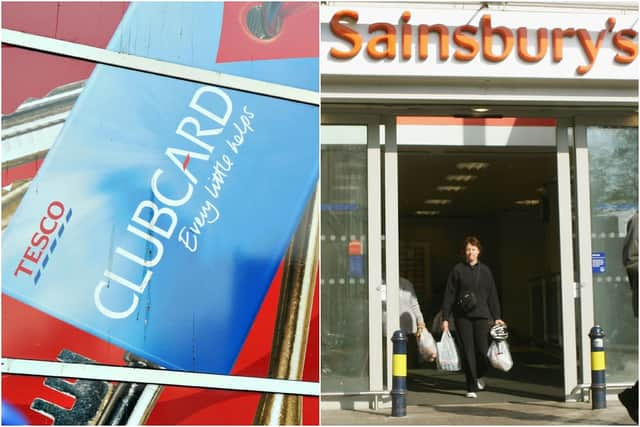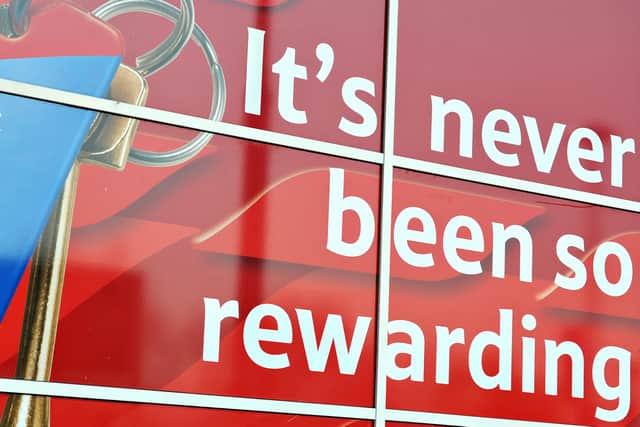Cost of living: Tesco and Sainsbury's under scrutiny after Which? uncovers dubious loyalty card offers
and live on Freeview channel 276
Watchdog Which? has said up to a third of Tesco and Sainsbury's loyalty offers are "not all they're cracked up to be", as it urged the competition watchdog to look into supermarket dual pricing.
141 Clubcard and Nectar card prices from Tesco and Sainsbury's were examined by the consumer group, who tracked them back six months. They discovered that about a third (29%) of the member-only promotions were at their supposedly "regular" price for less than 50% of the six-month period.
Advertisement
Hide AdAdvertisement
Hide AdBoth Sainsbury's and Tesco claimed that Which? had failed to account for inflation when analysing prices. Both companies emphasised that they had complied with Trading Standards regulations regarding promotions.
Which? identified three recurring problems around the “regular” price quoted for products on offer to customers with loyalty cards – that they were far more expensive than at other supermarkets, that they had been changed right before the promotion, or were only available for a short amount of time.
The findings are part of the watchdog’s investigation into the increasingly widespread use of loyalty card schemes across supermarkets, which only allows those customers who are signed up access to the lower tier of pricing.


Among the deals of concern to Which? was a jar of Nescafé Gold Blend Instant Coffee (200g) advertised at Sainsbury’s for £6 with a Nectar card – a saving of £2.10 on the “regular” price of £8.10. However the regular price had also been £6 at Sainsbury’s until it went up to £8.10 just two days before the Nectar price launched.
Advertisement
Hide AdAdvertisement
Hide AdWhich? also found the regular Sainsbury’s price was significantly higher than at other supermarkets, such as Asda, where the same jar cost £7, or at Morrisons, Ocado and Waitrose where it was available for £6. It was even cheaper at Tesco (£5.99) and at Lidl (5.49).
In another example, Which? found Heinz Salad Cream (605g) at Tesco with a Clubcard price of £3.50 and a regular price of £3.90, even though its regular price had been £2.99 for several weeks before it was increased to £3.90 – just 22 days before the Clubcard promotion.
Which? found the condiment has been its regular price for just 25 days out of 183, or 14% of the previous six months.
Overall, Which? found a third of the products at Sainsbury’s (34% of 71 products) were the “regular” price less than half the time over the previous six months. At Tesco, the same was true for 24% of the 70 items analysed.


Advertisement
Hide AdAdvertisement
Hide AdAs well as being clear and not making unfair price comparisons, current regulator guidance dictates that it is important that if a proposed pricing practice explicitly or by implication indicates a saving against another price, the quoted saving is genuine and can be trusted by shoppers.
Which? said it had shared its findings with the Competition and Markets Authority (CMA) and asked them to look at whether supermarkets could be hiking their “regular” prices to make loyalty scheme customers feel they are getting a discount.
A Sainsbury’s spokesperson said: “Nectar Prices offer our customers the opportunity to make genuine savings across 5,000 products. Which? fails to recognise that base prices have been increasing throughout the year due to inflation. Our promotional rules around Nectar Prices are informed by the guidance from Trading Standards.
“The Nescafe Gold example demonstrates Which?’s flawed methodology as the claim that the ‘regular’ price was £6 is untrue. The base price of this item has been £8.10 since December 2022 and £6 was a promotional price throughout this year, including on Nectar Prices when it launched in April.”
Advertisement
Hide AdAdvertisement
Hide AdA Tesco spokesperson said: “All our Clubcard Price promotions follow strict rules, including considering how they compare against prices in the market, to ensure they represent genuine value and savings for our Clubcard members. These rules have been endorsed by our Trading Standards Primary Authority.”
Which? also raised concerns that not all customers were able to sign up to the loyalty schemes in the first place, with age and address-based restrictions as well as digital requirements leaving groups such as young parents and carers, school children buying lunch and those in temporary accommodation potentially excluded from benefiting from lower prices – and possibly paying inflated normal prices.
A survey of 2,000 UK adults for Which? found that 20% of those who had noticed member-only pricing said it had led them to shop at their supermarket more frequently than before. Some 69% said they were willing to exchange their personal data for discounted prices.
Sue Davies, Which? head of food policy, said: “It’s not surprising that shoppers are questioning whether supermarket loyalty card prices are really a good deal, as our investigation shows that up to a third of loyalty offers at Tesco and Sainsbury’s are not all they’re cracked up to be.
Advertisement
Hide AdAdvertisement
Hide Ad“As member-only pricing continues to grow, the sector, its pricing practices and who is eligible for membership needs to be properly scrutinised so that all shoppers – including society’s most vulnerable – can benefit and no one is misled into buying things they wouldn’t have usually bought or which isn’t quite the deal they believe it to be.
“Which? is calling on supermarkets to make sure that their loyalty card prices don’t mislead and for the regulator to look more closely at this growing trend towards dual pricing. There is also the important issue of whether it is right for certain groups to be excluded from member-only schemes.”
Comment Guidelines
National World encourages reader discussion on our stories. User feedback, insights and back-and-forth exchanges add a rich layer of context to reporting. Please review our Community Guidelines before commenting.
